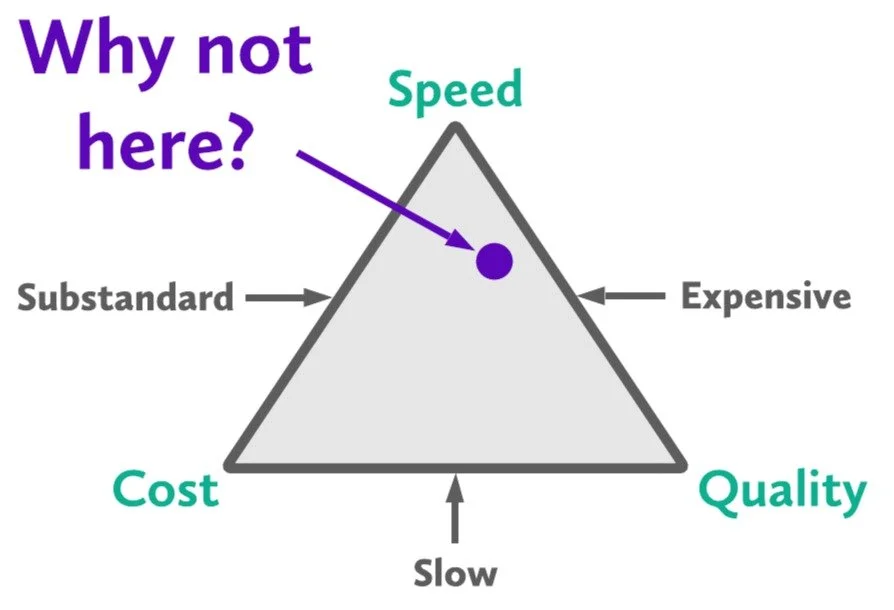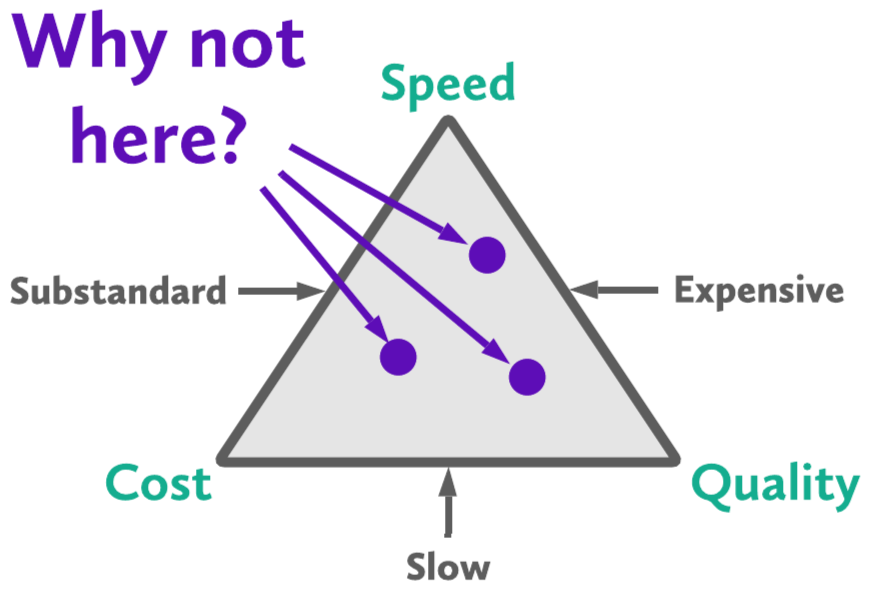Quality vs Speed vs Cost - A Fallacy
We all know the classic saying that you can only pick two between Quality, Speed, and Cost. Some of us know this as the “Unattainable Triangle” or “Priority Triangle” We’ve seen it said and drawn in infographics a thousand different ways but all with the same meaning. So if we take this to be accurate, then product owners have a tough decision to be made in the early days of their product development.
There is an inherent risk with any two you pick:
Quality & Speed - we are going to run out of money before we can generate meaningful traction
Quality & Cost - we are moving too slow and not generating revenue - can’t find product-market fit if your product isn’t in the market and your competition is
Speed & Cost - we might be able to complete our development and raise some money this round, but we have a bad foundation that we cannot continue to build on and will miss opportunities by not being able to seize the moment
At Mile Marker, we believe that the Quality, Speed, and Cost conundrum is a fallacy. It forces founders to paint with broad strokes and does not represent the reality of product development. For example, most SaaS products consist of many smaller projects such as Databases, APIs, Web Apps, Mobile Apps, etc. Well, why couldn’t each sub-project have its own Quality, Speed, and Cost balance?
Beyond this, there is a glaring flaw in the “pick two” nature of the relationship between Quality, Speed, and Cost. Specifically, the question is poorly worded - when most people ask this, what they mean is to pick between Best, Fastest, and Cheapest (the extremes). Why can’t I choose good-enough, fast-enough, and cheap-enough?
Many people think our argument is headed down the "pick a smaller triangle" path. While that is great and we always look for ways to trim scope, you still have to pick different combinations (and amounts) of Speed, Cost, and Quality even with a smaller triangle.
That leaves us with the question of how to balance these three variables. Ultimately, the answer is different for every company and every product. Some companies have a very low bug tolerance, some have a higher tolerance. Some companies want to target 100% of all use cases while some want to start with 80% and work towards the other 20%. Some companies want to validate designs with user testing before starting development then user test again after development is complete before release while other companies skip some of those steps.
The more important question to answer during product development is "what will my users/customers tolerate?". If your target market is technical vs non-technical, working on life and death critical systems, or working within established industries, this changes their tolerance level for edge case handling, unoptimized user experience, and workarounds. However, regardless of your market, you must build trust with your users. They need to trust that while there may be some issues in your product, you are working toward improving and fixing problems. The best way to build this trust is with transparent and consistent updates. A user's tolerance for issues (bugs, unoptimized user experience, missing features, etc) is much higher if they see fixes coming quickly.
So no, the answer is not to release a low-quality product and keep fixing it. The answer is to release a tolerable product and work towards excellence at a consistent and transparent rate. Tolerable depends on your company, your customers, your brand, your industry, and more but it is definable and it is understandable.
At Mile Marker, we work with our clients to understand their business to help advise on the intersection of “good-enough”, "fast-enough", and "cheap-enough". Often this can be obvious such as prioritizing database quality over cost or prioritizing release over a perfectly optimized user experience. However, there is a fine line that is almost always different for every company and every product. By working with our clients to understand their business as a whole (mission, core beliefs, customers, products, employees, culture, etc.), we can help guide them to the right balance.
Mile Marker’s success is measured by the success of our clients - if we can help our clients get to their next level, then we will get to our next level together.


